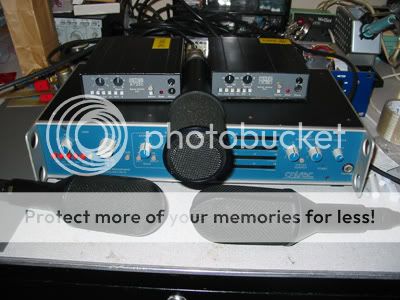Soundfields default to an MS output since it's the easiest, most compatible output to default to. Mono fold-down is always trouble-free, since there's never any timing differences: the system is coincident as opposed to spaced.
If you could reasonably DIY a tetrahedral head assembly (which really is the hard part!) then all you nave to do is generate a B-format output of W, X, Y and Z. W is just all four added together, X Y and Z are different subtractions from W.
Once you have that, you don't need to build a decoder... make a digital 4-channel recording of the B-format signal and use the free software plug-in decoders, or alternatively try the .exe extractors, which will generate surround outputs... up to sixteen channels I believe... They are on the web in a few places, Geniuses like Dave Malham at York University (right in Zebra50's backyard!) have worked on this and done all the really hard digital work for you!
I wonder if Zebra50 would be interested in trying a tetrahedral array... if so, I wonder if Dave Malham would be interested in helping in a one-off joint DIY "project to end all projects"? :grin:
About the only other tricky thing would be the fact that the outputs need to be calibrated. The picture of the MkIV vontrol unit on the bench (the big blue one) shows that it had meters on it. In the old days of analog recording, where calibrations would drift and often be rather approximate, even an error of 1dB between channels ruins total cancellation when required... so the "back" of the cardioid pattern is nowhere near as "dipped" as it should be for example.
For that reason, the MkIV has an oscillator out, which not only provides level for calibration and polarity check to help avoid the "oops!" factor; there are "nicks" encoded into the tone, where it dims in level by about 20dB or so... it identifies the channels in case the tracksheet is lost... record at the head or the tail for calibration and/or channel ID. 'W' has no nicks in it, 'X' has nicks every second, 'Y' every 2 seconds and 'Z' every 4 seconds... easy and fairly instinctive to set up.
Now that digital recording means that calibration drifts of several dBs are in all reality a thing of the past, the ST250s just output a B-format audio signal, no test tones for setup. All you do is record it with the same gain on every channel. -For this I intend to build a 4-channel balanced-output ganged gain box for my own recordings. (I get to use the newer repaired ST250 any time I want in return for repairing it... how cool is that!!!)
If anyone really really wants to DIY a soundfield-type mic, it's definately a do-able proposition; I would think that the biggest hurdle would be calibration, assuming that we can accuratley make the tetrahedral array... -For me that would appear to be another obstacle, but I've seen enough here on the LAB that's made me marvel at what some folks like Stewart, CJ, xvlk, Jakob, Tim Campbell and the like get up to in terms of manufacturing, I really no longer doubt that it's possible.
A couple of notes from using them:
The array isn't as big as you think. The capsules aren't as big as you think. They look to be about 15mm each instead of 25mm. Also, they are arrayed so that if you stand "front and center" you're not looking straight into one. They are left and right at 45-degrees (plan view only) and each one tilts up and down at the prescribed geometric angle. This is important since moving around the mic in a circle, you never appear on-axis to any of the capsules, so there are no on-axis "hot-spots" where the axial HF rise 'brightens' the sound.
Remember, after recording, these mics can still be 'panned, tilted and Zoomed' in case the mic wasnlt pointed in the right direction or something equally bizarre!
How do they sound? -Well, very 'natural'. There's no "warmth", no "Smoothness", no "Harshness" no "Brittleness"... no nothing really. -That's not a bad thing for me, that's a perfect thing. Recording stuff like classical music, that's exactly what you want! If you think of mics that have a "sound" as being like colour filters that a photographer uses in front of the lens to "tint" the photograph, yes a progressive sepia graduation can make a beach sunrise look stunning... but it will ruin a saturday afternoon wedding party shot... same for mics... there is often no outright "good or bad" when you look at it that way... the safest way to make the recording is like taking a photo using clear glass... no coloration. After that you can build what you want with balance changes. That's how the Soundfield works. Would I use it as a vocal mic in a Rock tune? Almost certainly not. It doesn't make anyone sound like a rock star! -Other mics 'sort-of' help people sound like your favourite rock star... with these mics, Johnny Warshowski from down the street still sounds like Johnny Warshowski... not Axl Rose or whoever...
So it sounds real. Very real!
Cool.
Keith



